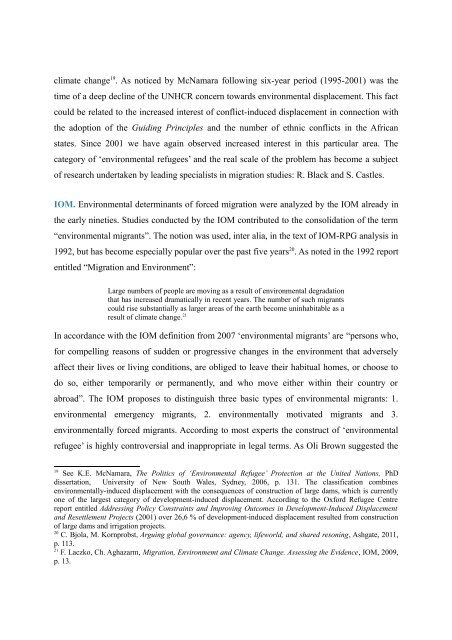Bogumil Terminski Environmentally-Induced Displacement ... - Cedem
Bogumil Terminski Environmentally-Induced Displacement ... - Cedem
Bogumil Terminski Environmentally-Induced Displacement ... - Cedem
- No tags were found...
You also want an ePaper? Increase the reach of your titles
YUMPU automatically turns print PDFs into web optimized ePapers that Google loves.
climate change 19 . As noticed by McNamara following six-year period (1995-2001) was thetime of a deep decline of the UNHCR concern towards environmental displacement. This factcould be related to the increased interest of conflict-induced displacement in connection withthe adoption of the Guiding Principles and the number of ethnic conflicts in the Africanstates. Since 2001 we have again observed increased interest in this particular area. Thecategory of ‘environmental refugees’ and the real scale of the problem has become a subjectof research undertaken by leading specialists in migration studies: R. Black and S. Castles.IOM. Environmental determinants of forced migration were analyzed by the IOM already inthe early nineties. Studies conducted by the IOM contributed to the consolidation of the term“environmental migrants”. The notion was used, inter alia, in the text of IOM-RPG analysis in1992, but has become especially popular over the past five years 20 . As noted in the 1992 reportentitled “Migration and Environment”:Large numbers of people are moving as a result of environmental degradationthat has increased dramatically in recent years. The number of such migrantscould rise substantially as larger areas of the earth become uninhabitable as aresult of climate change. 21In accordance with the IOM definition from 2007 ‘environmental migrants’ are “persons who,for compelling reasons of sudden or progressive changes in the environment that adverselyaffect their lives or living conditions, are obliged to leave their habitual homes, or choose todo so, either temporarily or permanently, and who move either within their country orabroad”. The IOM proposes to distinguish three basic types of environmental migrants: 1.environmental emergency migrants, 2. environmentally motivated migrants and 3.environmentally forced migrants. According to most experts the construct of ‘environmentalrefugee’ is highly controversial and inappropriate in legal terms. As Oli Brown suggested the19See K.E. McNamara, The Politics of ‘Environmental Refugee’ Protection at the United Nations, PhDdissertation, University of New South Wales, Sydney, 2006, p. 131. The classification combinesenvironmentally-induced displacement with the consequences of construction of large dams, which is currentlyone of the largest category of development-induced displacement. According to the Oxford Refugee Centrereport entitled Addressing Policy Constraints and Improving Outcomes in Development-<strong>Induced</strong> <strong>Displacement</strong>and Resettlement Projects (2001) over 26,6 % of development-induced displacement resulted from constructionof large dams and irrigation projects.20C. Bjola, M. Kornprobst, Arguing global governance: agency, lifeworld, and shared resoning, Ashgate, 2011,p. 113.21F. Laczko, Ch. Aghazarm, Migration, Environmemt and Climate Change. Assessing the Evidence, IOM, 2009,p. 13.
















